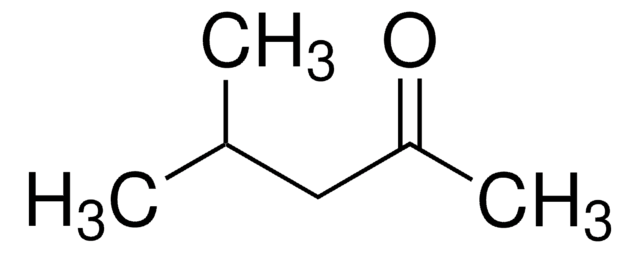8.22262
1-Butanol
EMPLURA®
Sinónimos:
1-Butanol, Butan-1-ol, n-Butyl alcohol, BuOH
About This Item
Productos recomendados
vapor pressure
6.7 hPa ( 20 °C)
Quality Level
product line
EMPLURA®
assay
≥99% (GC)
form
liquid
autoignition temp.
340 °C
potency
790 mg/kg LD50, oral (Rat)
3400 mg/kg LD50, skin (Rabbit)
expl. lim.
1.4-11.3 % (v/v)
impurities
≤0.2% Water (Karl Fischer)
evapn. residue
≤0.004%
pH
7 (20 °C, 70 g/L in H2O)
bp
116-118 °C/1013 hPa
mp
-89 °C
transition temp
flash point 34 °C
solubility
66 g/L
density
0.81 g/cm3 at 20 °C
storage temp.
2-30°C
InChI
1S/C4H10O/c1-2-3-4-5/h5H,2-4H2,1H3
InChI key
LRHPLDYGYMQRHN-UHFFFAOYSA-N
General description
Application
- Characterization and comparison of flavors in fresh and aged fermented peppers: Impact of different varieties: 1-Butanol is used in the analytical methods for evaluating flavor profiles in food research, highlighting its significance in food chemistry and quality control (Liu M et al., 2024).
- Controlling soft rot of green pepper by bacteriocin paracin wx3 and its effect on storage quality of green pepper: The study incorporates 1-Butanol in methodologies to examine the preservation and quality of green peppers, indicating its application in post-harvest technology and plant pathology (Yi L et al., 2024).
- Pathway toward Scalable Energy-Efficient Li-Mediated Ammonia Synthesis: This research utilizes 1-Butanol in processes related to energy-efficient synthesis technologies, underlining its potential in sustainable industrial applications (Kani NC et al., 2024).
Analysis Note
Density (d 20 °C/ 4 °C): 0.809 - 0.810
Water (K. F.): ≤ 0.20 %
Evaporation residue: ≤ 0.004 %
Identity (IR): passes test
Legal Information
signalword
Danger
Hazard Classifications
Acute Tox. 4 Oral - Eye Dam. 1 - Flam. Liq. 3 - Skin Irrit. 2
Storage Class
3 - Flammable liquids
wgk_germany
WGK 1
flash_point_f
95.0 °F - Pensky-Martens closed cup
flash_point_c
35 °C - Pensky-Martens closed cup
Certificados de análisis (COA)
Busque Certificados de análisis (COA) introduciendo el número de lote del producto. Los números de lote se encuentran en la etiqueta del producto después de las palabras «Lot» o «Batch»
¿Ya tiene este producto?
Encuentre la documentación para los productos que ha comprado recientemente en la Biblioteca de documentos.
Los clientes también vieron
Nuestro equipo de científicos tiene experiencia en todas las áreas de investigación: Ciencias de la vida, Ciencia de los materiales, Síntesis química, Cromatografía, Analítica y muchas otras.
Póngase en contacto con el Servicio técnico








